Make apple cider vinegar at home, using apple scraps or whole apples, with this easy tutorial. Save money, reduce food waste, and make ACV in under 5 minutes!
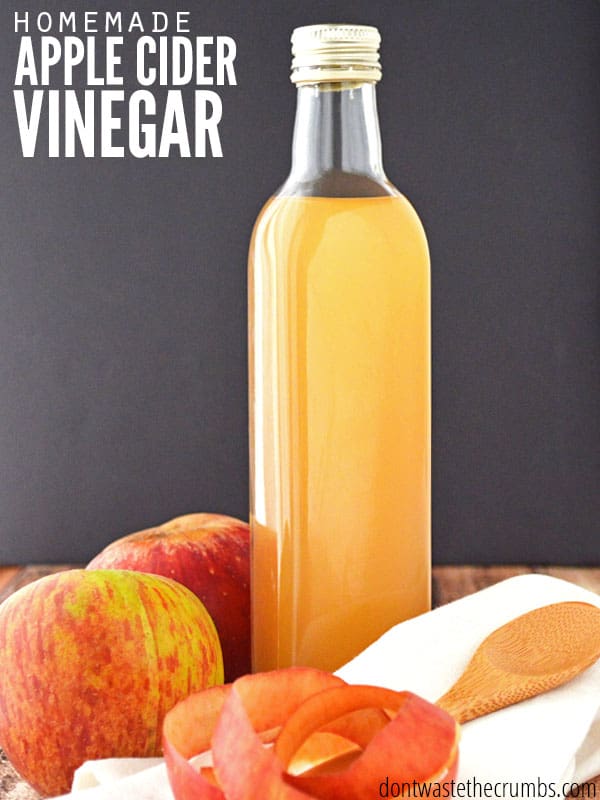
My kids absolutely LOVE apples. They’ll eat them fresh, dipped in Chocolate Hummus, or in their favorite make-ahead breakfast Apple Oatmeal Breakfast Bars (which also passes for dessert!).
But what do you do when you have a bunch of apples that go bad? Or have you ever wondered if there’s something you can do with the apple cores and apple peels, other than throw them away?
You can make apple cider vinegar!
Apple Cider Vinegar
There are two important things to know when you make ACV:
First, it’s free. There’s nothing special to buy just to make apple cider vinegar. You can use apple scraps (cores and peels) from any other recipe, OR you can use apples that don’t look very appetizing. In either case, you were going to throw the apple bits and pieces away anyway, so turning it into vinegar is a free bonus! (Here are more ideas for cooking with food scraps).
Second, making apple cider vinegar is VERY easy and VERY fast. You only need 3 ingredients and the entire process takes only 5 minutes from start to finish. The only downside is that your apple scrap vinegar is not officially ready until it’s sat for about 6 weeks.
If you need apple cider vinegar ASAP, the healthiest option is to purchase a brand that is raw, unpasteurized and has the mother. I really like Braggs, and you can get the best deal by buying in bulk.
You can still benefit from pasteurized apple cider vinegar though, so if that’s what’s in your budget, go for it!
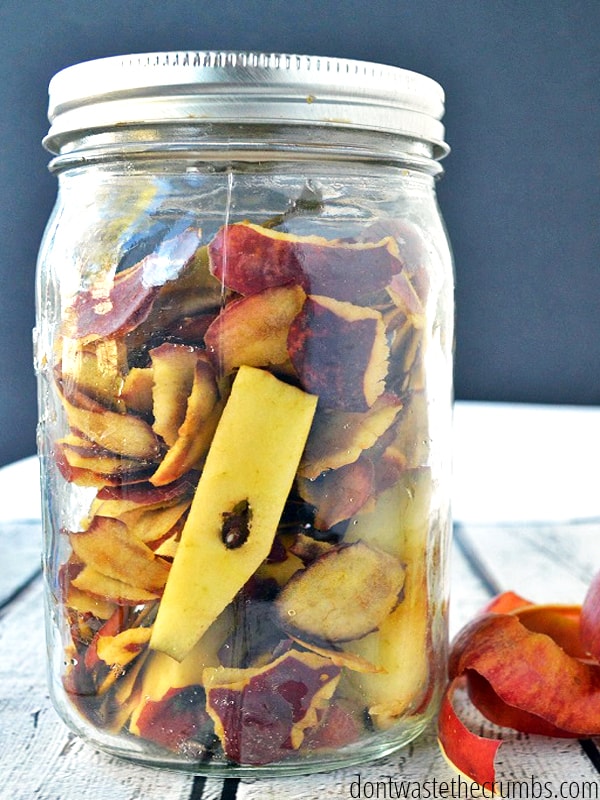
ACV Benefits
ACV benefits include reducing high cholesterol, stabilizing blood sugar, and improving heart health. It also aids in detoxing the liver and lymphatic systems.
Raw, unpasteurized apple cider vinegar will also have “good” bacteria (like yogurt) and enzymes that improve gut health. I want all of these health benefits, but store-bought can be pricey, which is why I learned how to make my own apple cider vinegar!
Supplies for Making Vinegar
- One wide mouth quart mason jar (or reuse a glass jar from spaghetti sauce or peanut butter)
- One canning lid ring (if using a canning jar) OR a rubber band
- Coffee filter OR paper towel
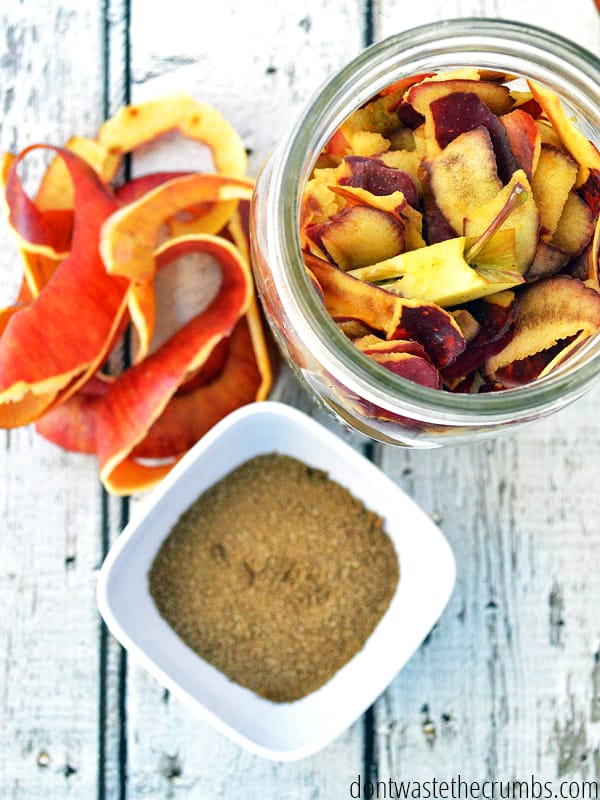
Homemade Vinegar Ingredients:
- Apple scraps from approximately 6 large apples (NOT moldy or rotten apples)
- 2 Tbsp granulated sugar (white granulated sugar is best)
- 2 cups water, boiled and allowed to cool
Tip: If you don’t have enough apple scraps to make ACV, freeze the cores and peels until you do! Place them in an airtight container that’s safe for the freezer. Label the container, and simply add additional cores and/or peels to the container as you have them. When you have about 6 apples worth, make homemade vinegar!
How to Make Apple Cider Vinegar at Home
Step 1: Measure 2 Tbsp of granulated sugar and ¼ cup of water into the quart jar. Stir until the sugar is dissolved.
Step 2: Fill the jar with apple pieces, filling no more than ¾ full. The apple scraps need room to expand and stay under the liquid.
Step 3: Add the remaining 1 ¾ cups of water to the jar. The apples should be completely submerged. Mold can grow on any portions of apples that are not covered and ruin your batch of vinegar. If your scraps float to the top of the jar add fermentation weights, fermentation springs, or a smaller jar on top (or a shot glass) to keep them submerged.
Step 4: Cover the top of the jar with a coffee filter and secure it with a canning lid or a rubber band.
Step 5: Allow apples to sit in a warm, dark place for two weeks. Above the refrigerator or on the top shelf of a cupboard are great places. Just don’t forget you put it there!
Step 6: After 2 weeks, you might notice some fizz or bubbles. That’s good news! Strain out the apple pieces and discard them. Cover the apple cider vinegar again with a filter and canning lid ring (or rubber band). Allow the vinegar to continue to sit at room temperature for another 2-4 weeks.
Step 7: The vinegar may become cloudy, or a SCOBY could form on the top, both of which are normal. At the 4-week mark from first initially making the vinegar, taste test the vinegar once a week until it’s fermented to your liking. You can stop the fermentation process by replacing the filter with a canning lid and storing it in the refrigerator.
For longer storage, I highly recommend swing-top glass jars like these. They keep the apple vinegar sealed to prevent further fermentation, and they’re easy to pour from. Plus, it frees up your mason jar for other things.
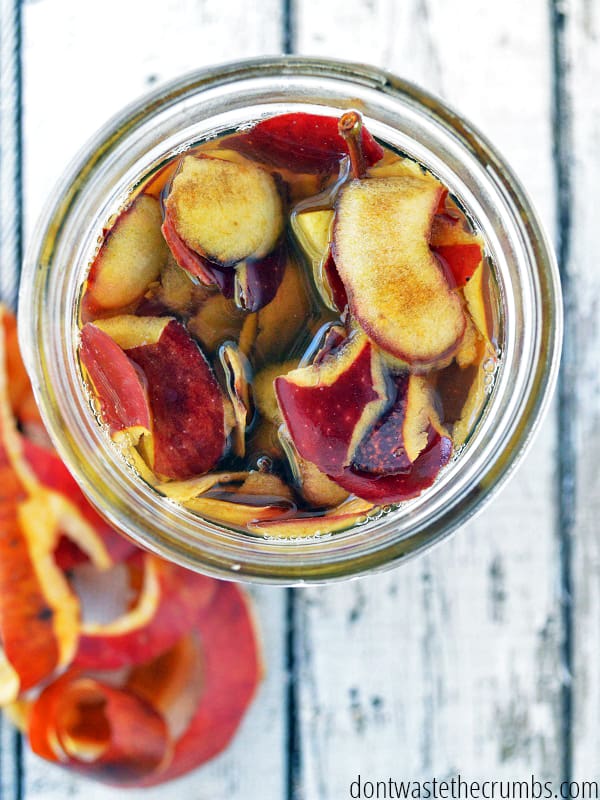
How to Make ACV (Using Whole Apples)
Follow the steps above for making apple cider vinegar using apple cores and apple skins, except use apples that are past their prime or not best for eating fresh, like mealy apples, wrinkly apples, or apples with bad spots. Simply cut out any bruises or bad spots from the apple and follow the tutorial as written to make ACV!
Does Apple Cider Vinegar Go Bad? ACV Storage Tips
Refrigerator: Store finished apple cider vinegar in the fridge to stop the fermentation process. You can keep it out on the shelf, but it will continue to get stronger in taste.
Freezer: I have not tried freezing ACV before, but I think you can! Use these tips to freeze liquids without breaking the jars.
Shelf-Life: Homemade apple cider vinegar will last up to a year when refrigerated. You should be able to tell by smell and taste if it has gone bad. The smell should always be vinegary with a hint of sweetness. If it smells sour, toss it, and start a new batch.
How to Make ACV: Troubleshooting and Tips
Make sure ALL of your supplies are clean. Dirty dishes can contaminate your homemade apple scrap vinegar, so be sure to start with a clean kitchen and a sterilized jar, clean bowls, and utensils.
Avoid chlorinated water. Most cities use chlorine to combat bacteria in water, but this small amount of chlorine can react with fermentation and vinegar. Be sure to use filtered water or boiled water that has cooled.
Don’t use metal containers. Metal containers will also react with fermentation and vinegar, so make sure you’re using only glass jars. (Silicone, wood, and plastic utensils are fine to use.)
Speed up the process: You can use apple cider vinegar as a “starter” and add 1 ½ Tbsp raw apple cider vinegar for every 2 cups of water to help kick start and speed up the fermentation process. If you do this, strain the apples after just one week and taste each week after that.
Make sure your jar is covered well with a coffee filter or paper towel so fruit flies can’t get inside!
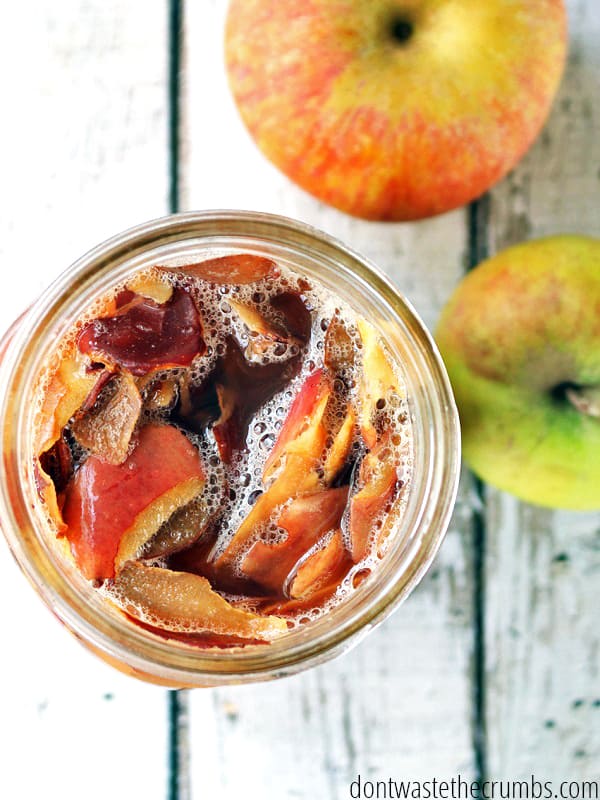
FAQs to Make ACV
What apples are best for making homemade apple cider vinegar?
The best apple types for homemade apple cider vinegar are the ones you already have at home! Seriously, there’s no right or wrong apple variety to make ACV. I think a combination of apples tastes best, but you could use a different fruit altogether – pear cider vinegar, pineapple vinegar, permission, fig, or anything else that sounds good to you!
Can I use honey instead of granulated sugar for fermentation?
You can substitute raw honey for sugar, but it will cause slower fermentation. Any sweetener you use will be eaten by the yeast anyway, so I prefer to use the least expensive sweetener possible. You can also omit the sweetener altogether, but the total fermentation time will be up to six months.
Can I make ACV from the mother?
Yes! You can use the vinegar mother from an existing ACV or a SCOBY as the starter in your next batch of ACV. Or you can give it to a friend to start her own batch of ACV!
How do you make apple cider vinegar at home?
Follow the tutorial above for making apple cider vinegar from entire apples or using apple cores and apple peels. Keep reading for ways to use your homemade apple cider vinegar in recipes and around the house!
My vinegar is moldy. Is it still good?
You will usually find white scum at the top when you make ACV, but you shouldn’t find mold. Be sure your apples stay submerged using fermentation weights, fermentation springs, or a smaller jar on top (or a shot glass). If you find mold in your apple vinegar, toss it out and try again.
What color should homemade apple cider vinegar be?
There are a lot of factors that affect color when you make ACV. It could be the apples you use, how long it ferments, and the temperature of where you store it! Mine typically stays a light color but has a distinct vinegar smell and taste.
What if my ACV turns slimy or thick?
Apples naturally contain a lot of pectin. This is what is used to thicken jellies and jams. If your ACV becomes thick, you can continue to ferment and then thin with water later. Organic homegrown apples tend to contain more pectin!
How Do You Use Homemade Apple Cider Vinegar?
Personal Use:
- As a detox elixir. Use this recipe for a short-term detox or an everyday start for your digestive system.
- An immune system booster. In addition to these immune-boosting fall foods, a tablespoon of ACV contains polyphenols and polysaccharides, which help your immune system.
- A facial toner. After using a homemade face wash like this, you can use apple cider vinegar as a toner. Top off with homemade lotion bars and your skin will thank you!
- To remove moles. I know this seems strange, but my husband tried it and it worked! Here’s his story.
- Homemade conditioner. Naturally condition hair with homemade ACV!
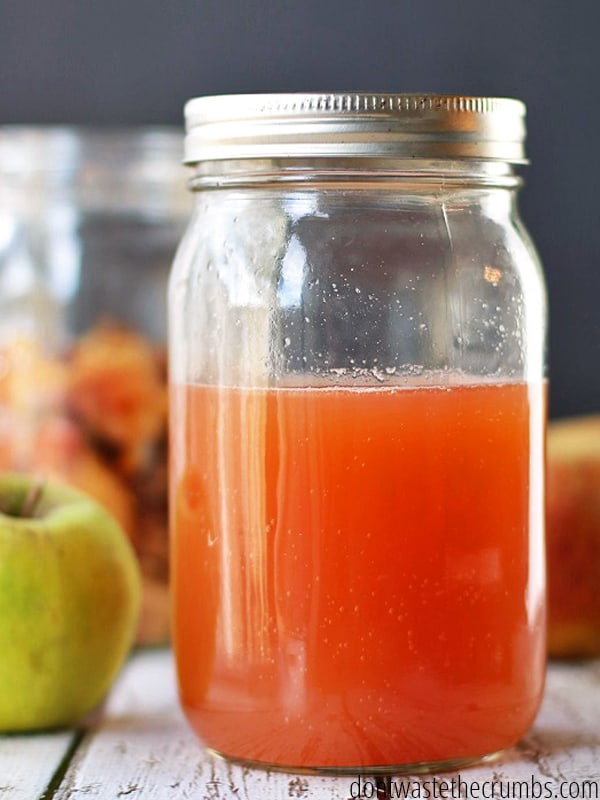
In the kitchen:
- To soak grains. Here is my method for soaking whole grains. Adding some apple cider vinegar helps the process work faster.
- To make salad dressing. This delicata squash salad recipe is one of my favorites that uses an apple cider vinegar dressing.
- Substituting for plain vinegar in recipes. Apple cider vinegar works really well in most recipes!
- Make bone broth. Whether you use the slow cooker chicken stock method or the Instant Pot chicken stock recipe, add 1-2 Tablespoons of ACV. This helps pull the nutrients out of the bones creating a true bone broth.
- In homemade mayo. My recipe for fail-proof mayo uses lemon juice. But if you’re out or don’t have fresh lemons on hand, ACV works in a pinch! The flavor is slightly different but still makes great mayo.
- Washing produce. Using vinegar is one of the natural ways to wash vegetables!
Around the house:
- To catch stray fruit flies. I tried this not long ago and it really works! The flies didn’t stand a chance in our homemade trap.
- To clean the house. You can take your finished apple cider vinegar and infuse it with citrus peels. This creates a nice-smelling cleaner you can use anywhere in the house.
Apple Recipes to Make Before You Make ACV
- Homemade Applesauce
- Apple Butter (plus 7 variations)
- Slab Apple Pie
- Homemade Apple Crumble Ice Cream
- Dehydrated Apple Chips
- Cranberry Apple Spinach Salad

No Cook Meal Plan
Sign up to get instant access to my No Cook Meal Plan, complete with recipes and shopping list!How to Make Apple Cider Vinegar
Make apple cider vinegar at home, using apple scraps or whole apples, with this easy tutorial. Save money, reduce food waste, and make ACV in under 5 minutes!
- Prep Time: 6 weeks
- Total Time: 6 weeks
- Yield: 32 oz 1x
- Category: Kitchen Hacks/Tutorials
- Method: Fermentation
- Cuisine: American
Ingredients
- Apple peels, cores and any browning/discolored flesh from pesticide-free apples (approx 6 large apples)
- One quart jar like these (or whatever you have on hand)
- One canning lid ring OR a rubber band
- Coffee filter OR paper towel
- 2–2 ½ Tbsp granulated sugar (I like Turbinado raw sugar)
- 2–2 ½ cups water, boiled and allowed to cool
Instructions
- Cover the bottom of your jar with apple scraps, filling no more than ¾ full. The apples need room to expand and stay submerged.
- Add 2 Tbsp of granulated sugar and 2 cups of filtered water to the jar. The apples should be completely submerged. Mold can grow on any portions of apples that are not covered and ruin your batch of vinegar. If your scraps float to the top of the jar add a smaller jar on top to keep them submerged.
- Stir the apples, sugar, and water and cover with a coffee filter. Secure with a canning band, or a rubber band.
- Allow apples to sit in a warm, dark place for 2 weeks. Above the refrigerator or on the top shelf of a cupboard are great places. Just don’t forget you put it there!
- After 2 weeks, you might notice some fizz or bubbles. That’s good news! Strain out the apple pieces and compost. Cover the apple cider vinegar again with a coffee filter and canning band. Allow continuing to sit at room temperature for another 2-4 weeks.
- The vinegar may become cloudy or a SCOBY could form on the top, both of which are normal. Taste test the vinegar once a week until it’s to your liking. You can stop the fermentation process by replacing the coffee filter with a canning lid and storing it in the refrigerator.
Notes
- Avoid chlorinated water. Most cities use chlorine to combat bacteria in water, but this small amount of chlorine can react with fermentation and vinegar. Be sure to use filtered water or boiled water that has cooled.
- Don’t use metal containers. Metal containers will also react with fermentation and vinegar, so make sure you’re using only glass jars. (Silicone, wood, and plastic utensils are fine to use.)Speed up the process: You can use apple cider vinegar as a “starter” and add 1 ½ Tbsp raw apple cider vinegar for every 2 cups of water to help kick start and speed up the fermentation process. If you do this, strain the apples after just one week and taste each week after that.
- Make sure your jar is covered well with a coffee filter or paper towel so fruit flies can’t get inside!
Nutrition
- Calories: 23

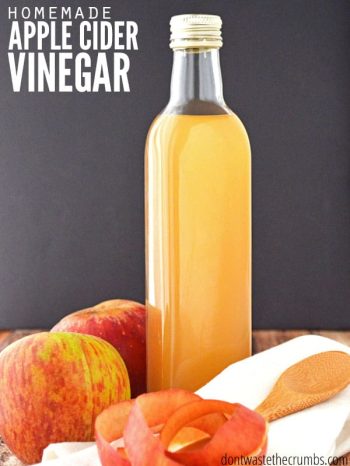
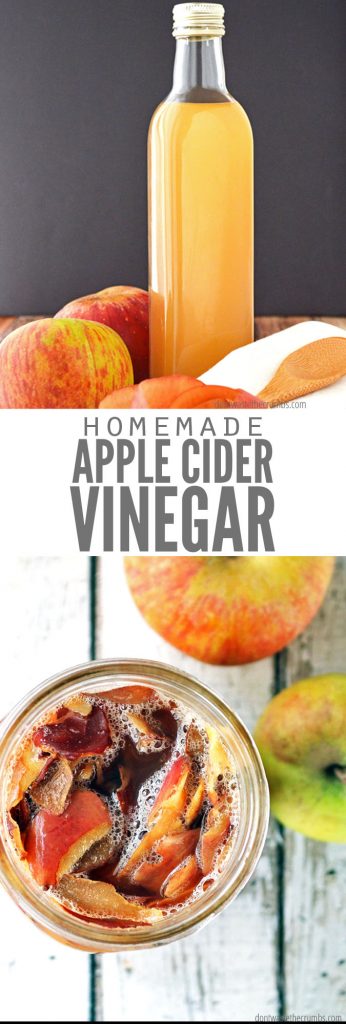

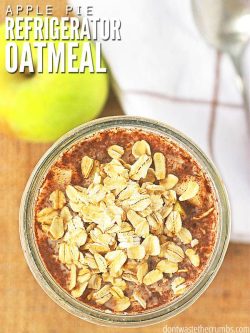
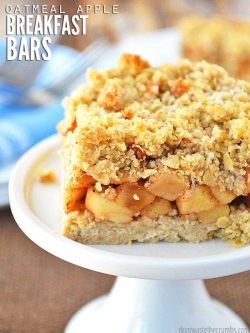


Brilliant! Accomplished my first batch after having an abundance of apples grow at home this year. Upon peeling to stew a lot of the apples I went on a hunt for “what can I make with apple core & peel” because I hate waste. I found your recipe and thought what have I got to lose?!
I’ve loved experimenting with this and just letting it sit and change its process. I felt clever, despite this being so damn simple. I made 2 jars. One is better than the other so I’m letting that one continue to sit for longer with filter. The other is now completed, canned and in the fridge. Thank you for your knowledge and sharing your recipe.
How do you infuse it with citrus peels to make a cleaner? I would really like to try this! Thanks so much!
Hello Tracy Ray,
The only difference would be to add the citrus peels to the jar. Hope this helps!
What is the acidity? Why didn’t you need to add acetic acid?
Will vinegar made this way still be effective as a cleaner?
I don’t understand the putting a jar thing on top to keep the apples down because then it just squished all the liquid out so the apples still aren’t covered? I tried using a coffee filter instead to keep the apples below the surface but then the top of the coffee filter molded and I considered the whole batch ruined. Does anybody else have any suggestions on how to fix this for next time?
Use fermenting weights
They sell glass weights for canning that you lay on top of whatever it is you want to remain submerged. On something like sauerkraut in a crock you can often use a plate or two to keep it under the surface of the liquid.
Fill a heavy zip-lock bag partially full with water & slip inside the top of the jar until the apples are submerged. It is easy to remove the bag of water, stir solution daily & reinsert the plastic bag.
I’m getting ready to make applesauce and wondering if you can use the peels from the already cooked apples? I throw the whole apple in cut up and cook. Then, I mill it out. Does it loose the effect? Trying to be more mindful in using everything and wasting less.
Hi Nikki,
We think that your method works fine. 🙂
Hi, a very interesting article, really liked your thought on making the ACV with leftover apple peels and core. Just don’t like the idea of wasting food 🙂
Would appreciate your advice as, i have left the Peel and Core in the refrigerator for a few days now as i was busy and just didn’t know what to do with it. Finally i found your amazing recipe and was wondering if i could still make ACV.
Just uncertain of the fermentation process would take place or not. Could you please guild.
Thank you
Hello Ruchika,
Yes, the peels and core are fine to use from the fridge, as long as they are not rotten or moldy. You can always use peels and cores for the future if you freeze them.
I made apple sauce using my food mill… I am trying to make Apple Cider Vinegar using the Ground up parts… I left them to “process”… It have been 4 weeks.. Is the the sediment on the bottom OK if it is pink? (I did used red apples)… I do not want to continue the process if this has gone bad…
Hi Debra,
It’s probably from the peels, but sometimes mold can be pink. So I guess it depends on your judgment of how pink the sediment is. There are a lot of factors that affect your ACV color. It could be the apples you use, how long it ferments, and the temperature of where your store it! Mine typically stays a light color but has the distinct vinegar smell and taste. Perhaps you could do a taste test?
I started to make ACV, after 10 days I’m opening up to strain my apple cores/peels and I see there several dead fruitflies in my ACV juice.
Do I need to discard? Or can I strain and keep fermenting?
Hi Bridget,
I suppose that’s really up to your preference if you want strain and continue. I don’t think it would affect the fermentation process. Hope this helps! 🙂
I keep my peels on the apples through the boiling process when I make applesauce and then strain them and run them through the food mill which removes the skins from the apples while giving it a beautiful pink color. My question is, can I use the cooked peels once they’ve been strained from the applesauce to make the ACV (or the wine or other recipes that utilize the discarded apple parts)?
Hi Valerie,
Boiling the peels before fermenting them will change how they ferment. We haven’t tested it and we’re not sure we can recommend it. TFoods that ferment need to be “live” and boiling them stops that.
I’ve been making this, using my own apples, for several years now. So just wanted to say ‘thank you’ for the recipe. It never fails, and makes the most delicious ACV. I tell everyone who will listen about it! Best wishes.
You’re most welcome Rosemary! 🙂
What do I do if there is white stuff on the top after 2 weeks?
Kim,
Is the white stuff mold?
1st time and on week 3…doing great. I used large pickle jars and a slew of little green apples. Tastes good so far. Kept in garage with a paper bag over them. Now in house in cool dark spot for another 2 weeks. Can’t wait for tasting upcoming weeks
rlh
Thank you so much for sharing Rebecca! So glad to hear it’s working well so far. 🙂
Such an easy & simple recipe to follow!! I used leftover apple cores & peels from making applesauce. It’s interesting to see how one jar differs from the other!
That’s awesome! And it is neat to see how they differ. 🙂
Would cooking the fermented apple cider vinegar (after taking out the scraps) cause it to be pasteurized? If so, at what temperature and for how long? I like being able to leave mine on a shelf. Also, how long would it stay good for after this process?
Hi Beth, We aren’t sure. We recommend storing this recipe in the fridge. If you find another recipe for how to pasteurize ACV be sure to report back and let us know. 🙂
I am very interested in trying to make ACV from scratch when I came across your recipe. What about the apple seeds? I thought they were poisonous for consumption?
Hello, how much honey must I use instead of sugar to make acv??
Hi May,
You can use the same amount but know that the fermentation process eats up all the sugar. Honey makes the fermentation take way longer and it’s more expensive than sugar. It can also taint the flavor. Hope that helps!
Allison, I would suggest starting over because it sounds like it could be a different type of mold. Good luck on your next batch, trust me I understand how frustrating new projects can be!
Great article thanks thanks the share. I’ve been fermenting my apples now for 4 days. The whole mixture has turned thick and slimy due to pectin. No mould at all. I read on your post I could thin it out with water. Would you suggest I do that now while it’s fermenting (Just add more water and mix until it’s thin since I’m only in the early stages) or after when I strain out my apples?
Hi Rob,
You can do it while it’s fermenting. Hope this helps! 🙂
Great Article Jennifer, Thanks for sharing with us. I wanted to come up with something tasty for my kids to boost their immunity. My kids are taking Vitamin C Candies but your article motivates me for Home made apple cider. What we can do to give citrus taste touch? My kids loves citrus taste actually.
Test out different drink mixtures that hide the vinegar after taste or look into apple cider vinegar vitamins at Target or Walmart.
When you remove the apple scraps and let it sit for a couple more weeks to get more vinegary, can you put a lid on it at that point? Or do you still leave the top open and covered?
The greater the air flow, the faster it will ferment. So you CAN certainly seal it, but it will take a bit longer to get the acidity level you’re used to.